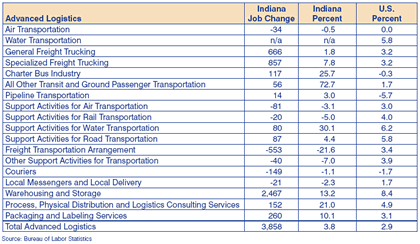Monthly Metrics: Indiana's Economic and Workforce Indicators
Percent Change in Average Weekly Wages, 2002:4 to 2004:4
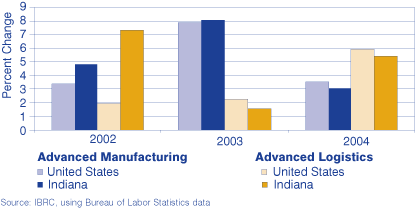
Indiana's average weekly wages for advanced manufacturing in 2004 increased at a slower rate (3.0 percent) than the nation's 3.5 percent. In 2003, Indiana's advanced logistics industry cluster experienced a modest increase (1.6 percent) in average weekly wages, compared to the nation's 2.3 percent increase. Indiana narrowed the gap in 2004 with a 5.4 percent increase, trailing the nation by only 0.6 percentage points.
Percent Change in Jobs, 2002:4 to 2004:4
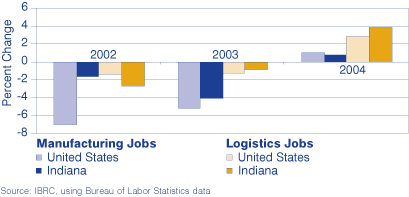
The percent change in advanced logistics and advanced manufacturing jobs has taken a turn for the better in 2004 for both Indiana and the United States. However, total advanced manufacturing jobs in Indiana are still 5 percent below the state's 2001 level, better than the nation's 11 percent decline. On the other hand, both Indiana's and United States' advanced logistics jobs have had a small increase on both a numeric and percentage basis.
Advanced Logistics Over-the-Year Change in Jobs, 2004:4
Warehousing and storage in the advanced logistics sector saw the largest over-the-year increase in total number of jobs. Freight transportation saw the largest percent decline in Indiana, 25.1 percentage points lower than the nation's growth. Overall, the state experienced greater growth than the nation in this industry cluster.
Advanced Manufacturing Job Change, 2004:4
The increase in jobs for transportation equipment manufacturing more than offset the large decline in primary metal manufacturing jobs over the previous year. Overall, the United States outpaced Indiana's growth by 0.2 percentage points.
Average Weekly Unemployment Benefits*
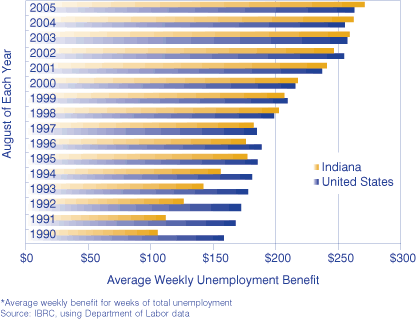
For the past three years, Indiana's average weekly unemployment benefit has been higher than the nation's. In 2005, Indiana's average weekly benefit exceeded the nation by $8.31 ($432 for the year), up from last year's difference of $6.67 per week (about $347 for the year).
Personal Income and Earnings by Geography, Second Quarter of Each Year*
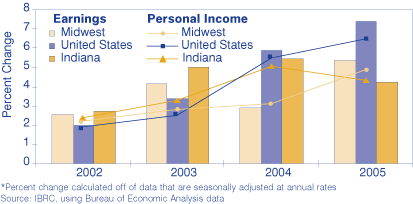
Indiana's percent change in personal income did not fare as well in 2005 as did the personal income for the Midwest or the United States. While Indiana's overall earnings increased, the pace of growth in earnings decreased by 1.2 percentage points, further separating Indiana from the Midwest (2.4 percentage points increase) and the United States (1.5 percentage points increase). Note: Personal Income is the income that is received by all persons from all sources. It is calculated as the sum of wage and salary disbursements, supplements to wages and salaries, proprietors' income with inventory valuation and capital consumption adjustments, rental income of persons with capital consumption adjustment, personal dividend income, personal interest income and personal current transfer receipts, less contributions for government social insurance.
Earnings by place of work is the sum of wage and salary disbursements,
supplements to wages and salaries and proprietors' income.
All state and local area dollar estimates are in current dollars (not adjusted
for inflation).
Number of Indiana Families Receiving TANF Grants, 2002 to 2005
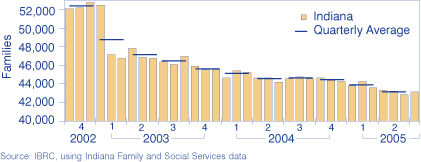
Click
for image with months labeled
Indiana has experienced a relatively steady decline in the number of families receiving Temporary Assistance for Needy Families (TANF) grants for the past three years; the quarterly average decreased 3.1 percent from 2004:2 to 2005:2. Note: The sharp decrease from January 2003 to February 2003 was due to a policy change that eliminated the full benefit grant and created $0 grants, removing those cases from the federal caseload. There have been no substantive changes in eligibility policy since February 2003.

